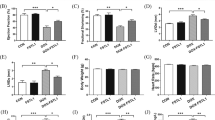Abstract
Neurodegenerative disorders are dreadful diseases that affect millions of people worldwide. Mitochondrial dysfunction is closely associated with the development of neurodegenerative disorders. Phoenixin 20 is a newly discovered neuropeptide with a pleiotropic effect. This study showed that the presence of Phoenixin 20 promoted neuronal mitochondrial biogenesis in vitro. In cultured neuronal M17 cells, Phoenixin 20 increased the expression of mitochondrial regulators PGC-1α, NRF-1, and TFAM at both mRNA and protein levels. The treatment of Phoenixin 20 increased the ratio of mitochondrial vs nuclear DNA (mtDNA/nDNA) and the multiple mitochondrial gene expression as revealed by increasing mRNA expression of Tomm22, Timm50, Atp5d, Ndufs3, and protein expression of NDUFB8. At a cellular level, Phoenixin 20 promoted mitochondrial respiratory rate and cellular ATP production. Mechanistically, we found that Phoenixin 20 induced the phosphorylation of CREB, which suggests that Phoenixin 20 promoted the activation of the CREB pathway. The blockage of CREB by its selective inhibitor H89 prevented the effect of Phoenixin 20 on mitochondrial regulators and biogenesis. Moreover, the study showed that Phoenixin 20 induced the expression of its tentative receptor GPR173 at the mRNA and protein level, and the silence of GPR173 in neuronal cells ablated all its effect on mitochondrial regulation. Collectively, we showed that Phoenixin 20 promoted neuronal mitochondrial biogenesis via the regulation of CREB–PGC-1α pathway. This study revealed a new role and underlying mechanism of Phoenixin 20 in neuronal cells, suggesting it influences the therapeutic implication of neurodegenerative diseases.








Similar content being viewed by others
References
Belgacem YH, Borodinsky LN (2017) CREB at the crossroads of activity-dependent regulation of nervous system development and function. Adv Exp Med Biol 1015:19–39
Dugger BN, Dickson DW (2017) Pathology of neurodegenerative diseases. Cold Spring Harb Perspect Biol 9(7):a028035
Gleyzer N, Vercauteren K, Scarpulla RC (2005) Control of mitochondrial transcription specificity factors (TFB1M and TFB2M) by nuclear respiratory factors (NRF-1 and NRF-2) and PGC-1 family coactivators. Mol Cell Biol 25:1354–1366
Golpich M, Amini E, Mohamed Z, Azman Ali R, Mohamed Ibrahim N, Ahmadiani A (2017) Mitochondrial dysfunction and biogenesis in neurodegenerative diseases: pathogenesis and treatment. CNS Neurosci Ther 23:5–22
Hyder F, Rothman DL, Bennett MR (2013) Cortical energy demands of signaling and nonsignaling components in brain are conserved across mammalian species and activity levels. Proc Natl Acad Sci USA 110:3549–3554
Jiang H, Kang SU, Zhang S, Karuppagounder S, Xu J, Lee YK, Kang BG, Lee Y, Zhang J, Pletnikova O, Troncoso JC, Pirooznia S, Andrabi SA, Dawson VL, Dawson TH et al (2016) Adult conditional knockout of PGC-1α leads to loss of dopamine neurons. eNeuro. https://doi.org/10.1523/ENEURO.0183-16.2016
Johnson IP (2015) Age-related neurodegenerative disease research needs aging models. Front Aging Neurosci 7:168
Johri A, Beal MF (2012) Mitochondrial dysfunction in neurodegenerative diseases. J Pharmacol Exp Ther 342:619–630
Jornayvaz FR, Shulman GI (2010) Regulation of mitochondrial biogenesis. Essays Biochem 47:69–84
Kang I, Chu CT, Kaufman BA (2018) The mitochondrial transcription factor TFAM in neurodegeneration: emerging evidence and mechanisms. FEBS Lett 592:793–811
Kelly DP, Scarpulla RC (2004) Transcriptional regulatory circuits controlling mitochondrial biogenesis and function. Genes Dev 6:357–368
Larco DO, Semsarzadeh NN, Cho-Clark M, Mani SK, Wu TJ (2013) β-Arrestin 2 is a mediator of GnRH-(1–5) signaling in immortalized GnRH neurons. Endocrinology 154:4726–4736
Li PA, Hou X, Hao S (2017) Mitochondrial biogenesis in neurodegeneration. J Neurosci Res 95:2025–2029
Matsumoto M, Saito T, Takasaki J, Kamohara M, Sugimoto T, Kobayashi M, Tadokoro M, Matsumoto S, Ohishi T, Furuichi K (2020) An evolutionarily conserved G-protein coupled receptor family, SREB, expressed in the central nervous system. Biochem Biophys Res Commun 272:576–582
Mcilwraith EK, Belsham DD (2018) Phoenixin: uncovering its receptor, signaling and functions. Acta Pharmacol Sin 39:774–778
Moreira PI, Zhu X, Wang X, Lee HG, Nunomura A, Petersen RB, Perry G, Smith MA (2010) Mitochondria: a therapeutic target in neurodegeneration. Biochim Biophys Acta 1802:212–220
Nikoletopoulou V, Tavernarakis N (2014) Mitochondrial biogenesis and dynamics in neurodegeneration: a causative relationship. Neurochem Res 39:542–545
Puigserver P, Adelmant G, Wu Z, Fan M, Xu J, O'Malley B, Spiegelman BM (1999) Activation of PPARgamma coactivator-1 through transcription factor docking. Science 286:1368–1371
Raichle ME, Gusnard DA (2002) Appraising the brain's energy budget. PNAS 99:10237–10239
Schalla MA, Stengel A (2018) Phoenixin-A pleiotropic gut-brain peptide. Int J Mol Sci 19(6):E1726
Stein LM, Tullock CW, Mathews SK, Garcia-Galiano D, Elias CF, Samson WK, Yosten GL (2016a) Hypothalamic action of phoenixin to control reproductive hormone secretion in females: importance of the orphan G protein-coupled receptor Gpr173. Am J Physiol Regul Integr Comp Physiol 311:R489–496
Stein LM, Tullock CW, Mathews SK, Garcia-Galiano D, Elias CF, Samson WK, Yosten GL (2016b) Hypothalamic action of phoenixin to control reproductive hormone secretion in females: importance of the orphan G protein-coupled receptor Gpr173. Am J Physiol Regul Integr Comp Physiol 311:R489–R496
Taherzadeh-Fard E, Saft C, Akkad DA, Wieczorek S, Haghikia A, Chan A, Epplen JT, Arning L (2011) PGC-1alpha downstream transcription factors NRF-1 and TFAM are genetic modifiers of Huntington disease. Mol Neurodegener 26:32
Treen AK, Luo V, Belsham D (2016) Phoenixin activates immortalized GnRH and kisspeptin neurons through the novel receptor GPR173. Mol Endocrinol 30:872–888
Uchiumi T, Kang D (2012) The role of TFAM-associated proteins in mitochondrial RNA metabolism. Biochim Biophys Acta 1820:565–570
Yanai T, Kurosawa A, Nikaido Y, Nakajima N, Saito T, Osada H, Konno A, Hirai H, Takeda S (2016) Identification and molecular docking studies for novel inverse agonists of SREB, super conserved receptor expressed in brain. Genes Cells 21:717–727
Yosten GL, Lyu RM, Hsueh AJ, Avsian-Kretchmer O, Chang JK, Tullock CW, Dun SL, Dun N, Samson WK (2013) A novel reproductive peptide, phoenixin. J Neuroendocrinol 25:206–215
Author information
Authors and Affiliations
Corresponding author
Additional information
Publisher's Note
Springer Nature remains neutral with regard to jurisdictional claims in published maps and institutional affiliations.
Rights and permissions
About this article
Cite this article
Yang, Y., Lv, Y., Liu, J. et al. Phoenixin 20 promotes neuronal mitochondrial biogenesis via CREB–PGC-1α pathway. J Mol Hist 51, 173–181 (2020). https://doi.org/10.1007/s10735-020-09867-8
Received:
Accepted:
Published:
Issue Date:
DOI: https://doi.org/10.1007/s10735-020-09867-8




